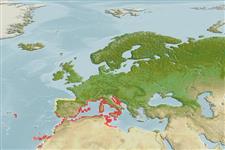Actinopterygii (ray-finned fishes) >
Anguilliformes (Eels and morays) >
Ophichthidae (Snake eels) > Ophichthinae
Etymology: Apterichtus: From the Greek ??????? (apteron), without fins, and ????? (ichtus, more correctly written ichthys;
masculine), fish..
Environment / Climate / Range
Ecology
Marine; demersal; depth range 10 - 250 m (Ref. 101270). Subtropical, preferred ?; 45°N - 20°N, 26°W - 17°E
Eastern Atlantic: Mediterranean coast of Israel; from Utica Island, southern Tyrrhenian Sea;, from Madeira, the Canary and Cape Verde Islands; possibly from Angola.
Size / Weight / Age
Maturity: Lm ? range ? - ? cm
Max length : 49.3 cm TL male/unsexed; (Ref. 4455)
Short description
Morphology | Morphometrics
Vertebrae: 150 - 157. This species is distinguished by the following characters: tail 1.8-2.0 in TL; head 14-16 in TL; body depth 59-100 in TL; preopercular pores 3; supratemporal canal with 3 pores; conical teeth, uniserial on jaws and vomer; vomerine teeth 2-4; coloration reddish or brownish, tip of jaws black, belly whitish; sometimes a large number of small darker patches on back and upper side; MVF 73-154, total vertebrae 150-157(n=8). (Ref. 101270).
Burrows in sand or mud on the continental shelf (Ref. 4455).
Life cycle and mating behavior
Maturity | Reproduction | Spawning | Eggs | Fecundity | Larvae
Distinct pairing (Ref. 205).
McCosker, J.E. and Y. Hibino, 2015. A review of the finless snake eels of the genus Apterichtus (Anguilliformes: Ophichthidae), with the description of five new species. Zootaxa 3941(1):49-78. (Ref. 101270)
IUCN Red List Status (Ref. 115185)
CITES (Ref. 94142)
Not Evaluated
Threat to humans
Harmless
Human uses
More information
Age/SizeGrowthLength-weightLength-lengthLength-frequenciesMorphometricsMorphologyLarvaeLarval dynamicsRecruitmentAbundance
ReferencesAquacultureAquaculture profileStrainsGeneticsAllele frequenciesHeritabilityDiseasesProcessingMass conversion
Tools
Special reports
Download XML
Internet sources
Estimates of some properties based on models
Phylogenetic diversity index (Ref.
82805): PD
50 = 0.5000 [Uniqueness, from 0.5 = low to 2.0 = high].
Bayesian length-weight: a=0.00151 (0.00061 - 0.00373), b=2.91 (2.70 - 3.12), in cm Total Length, based on LWR estimates for this (Sub)family-body shape (Ref.
93245).
Trophic Level (Ref.
69278): 4.0 ±0.7 se; Based on size and trophs of closest relatives
Resilience (Ref.
69278): High, minimum population doubling time less than 15 months (Preliminary K or Fecundity.).
Vulnerability (Ref.
59153): Low to moderate vulnerability (30 of 100) .
